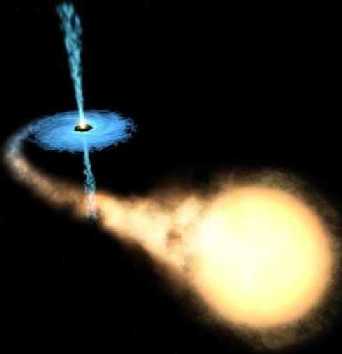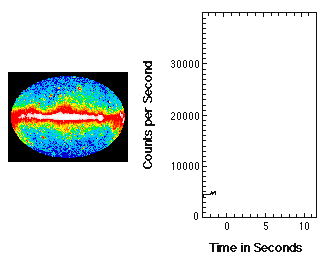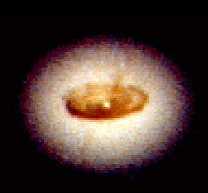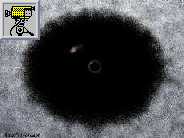Black holes
When a star, with an initial mass greater than 25 solar mass![]() , explodes as a type II supernova
, explodes as a type II supernova![]() and the remnant is a dense core of more
than 3 solar mass
and the remnant is a dense core of more
than 3 solar mass![]() , the object is not able to maintain its state of equilibrium, because no force is strong
enough to balance the gravitational force.
, the object is not able to maintain its state of equilibrium, because no force is strong
enough to balance the gravitational force.
Astrophysicists believe that the collapse cannot be stopped and the matter contracts up into a null volume. Nothing can
escape from the result of this collapse, neither radiation![]() , nor matter, therefore J. A. Wheeler suggested
calling such an object a Black Hole (BH). The existence of BHs has been detected, very probably, among the members of binary systems. (Fig. 1 and 2).
, nor matter, therefore J. A. Wheeler suggested
calling such an object a Black Hole (BH). The existence of BHs has been detected, very probably, among the members of binary systems. (Fig. 1 and 2).
 |
Fig. 1: Artist's impression of the binary sistem GRO J1677-40: the black hole receives mass from a disk (in blue), called
an accretion disk, continuously accreted by the companion. Not all the matter falls in the black hole: some is ejected in two streams perpendicular to the disk plane. (Credit: STScI-ESA-NASA; 30/11/2002) |
According to the theory of relativity, if a photon has a frequency f, to its energy hf is associated a mass hf/c2, where h is the Planck constant![]() ; for this reason light
; for this reason light![]() is subject to gravity. If the photons try to escape from the black hole, they will have an
increasingly long wavelength, while the frequency and energy tend to zero
(gravitational redshift) so they will disappear. In a body with mass M there is a spherical surface, called "event horizon" (Fig. 2) from
inside of which not even the light is able to escape from the irresistible gravitational attraction. The radius of this sphere is called "Schwarzschild radius
is subject to gravity. If the photons try to escape from the black hole, they will have an
increasingly long wavelength, while the frequency and energy tend to zero
(gravitational redshift) so they will disappear. In a body with mass M there is a spherical surface, called "event horizon" (Fig. 2) from
inside of which not even the light is able to escape from the irresistible gravitational attraction. The radius of this sphere is called "Schwarzschild radius![]() ".
".
In 1974 S. Hawking used quantum mechanics to demonstrate that on times much longer than the
age of the Universe the black holes can "evaporate".
Some astronomers think that the formation of black holes is related to the Gamma-Ray
Burst![]() (GRB), which are the occurrence in unforeseeable points of the sky of short and strong pulses of gamma radiation (Fig. 3
and 4).
(GRB), which are the occurrence in unforeseeable points of the sky of short and strong pulses of gamma radiation (Fig. 3
and 4).
 |
Fig. 3 and 4: On the left we can see the explosion of a GRB out of our galactic plane (represented by a white and red horizontal line). To the right is represented the light curve of the same GRB in number of photons per second against the time. (Credit: NASA/MSFC) |
In addition to the black holes born from the evolutionary processes of a single star and having at most some tens
of solar mass![]() , there are BHs of great mass, like those found in the central nuclei of many galaxies
, there are BHs of great mass, like those found in the central nuclei of many galaxies![]() (our galaxy included). These objects weigh millions or billions of solar mass (Fig.
5).
(our galaxy included). These objects weigh millions or billions of solar mass (Fig.
5).
 |
Fig. 5: Dust and gas forming an accretion disk of 800 light years of radius,
which feeds the central massive black hole in the nucleus of the NGC 4261 galaxy. (Credit: Foto NASA 04/12/1995) |
